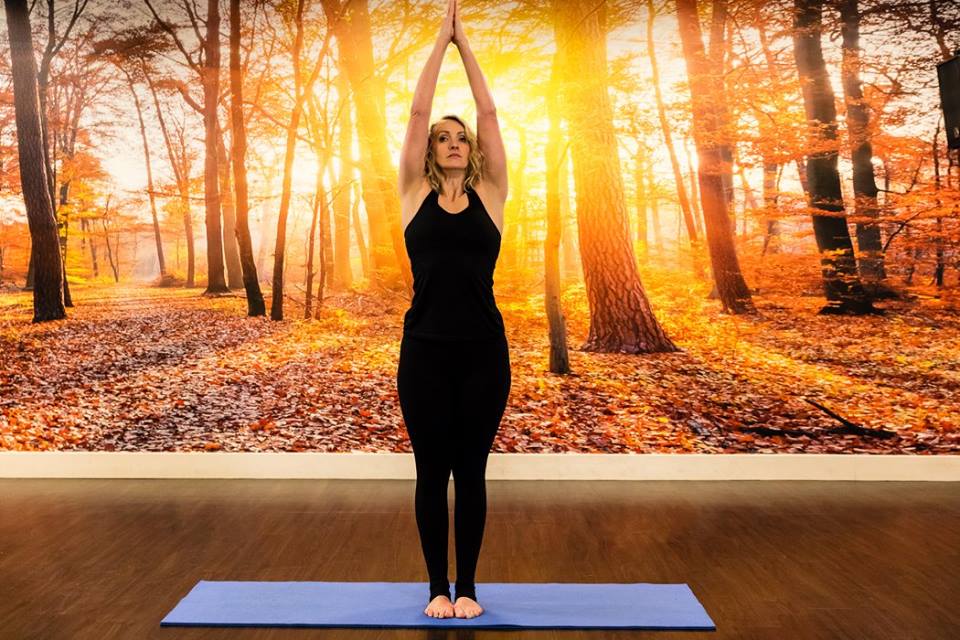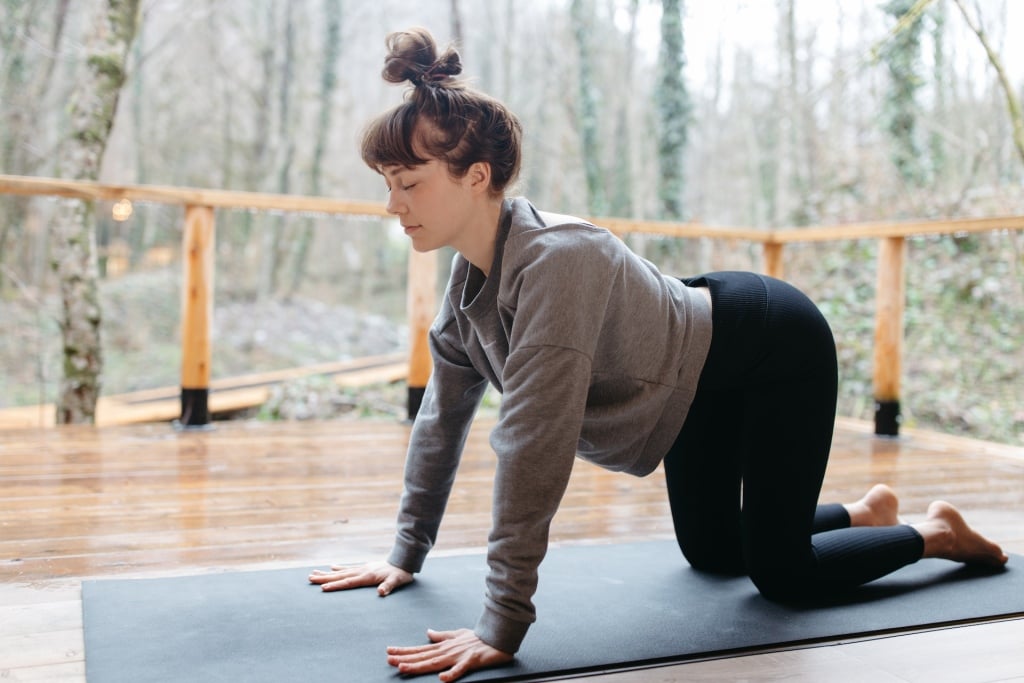It’s a fact of life: Stress is everywhere, and its causes are many and varied. But that doesn’t mean we’re powerless to do anything about it. In fact, one of the most effective stress-busting activities is free, needs no special equipment and takes just a little practice. Yes, we’re talking about yoga.
Among yoga’s many physical and mental health benefits, it has been proven to significantly lower blood pressure, enhance flexibility, improve posture and reduce muscle tension, which makes it an excellent way to relieve the physical symptoms of anxiety and stress. The key is to simply set aside some time and get started.
With that simple goal in mind, here are some of our favourite stress-reducing, flexibility-boosting, beginner-friendly, equipment-free poses. Follow them in sequence or just pick one or two if you’re short on time — and remember to hold each pose for three breath cycles, inhaling and exhaling with controlled calmness.
Easy Pose

Children often sit in this position, but adults tend to develop tight hips after spending so much time sitting in chairs. The easy pose opens the hips, strengthens the back and stretches the knees and ankles. It is also a calming pose that is regularly used in meditation and breathing exercises.
- Place supportive padding on the ground (a blanket, for example) so your hips will be higher than your knees when you get into position.
- Sit cross-legged on your padding.
- Adjust so your shoulders are aligned over your hips, then slide your shoulder blades down and raise the crown of your head towards the ceiling.
- Rest your hands in your lap or on your thighs, then either turn your palms up to be receptive or down to feel grounded.
- Feel your spine grow as you breathe in.
Extended Mountain Pose

Extended Mountain pose helps to properly align the spinal column, which in turn brings a calming awareness of your entire body. As well as strengthening the thigh muscles, it helps to open the chest and lungs, allowing for deep breathing and anxiety relief.
- Start with your arms alongside your body and your feet together. If you struggle to balance, stand with your feet hip distance apart instead.
- Inhale as you raise both arms above your head.
- Keep your legs straight but not locked, engaging your quads as you rotate your inner thighs towards the back of the room.
- Your ankles, hips, shoulders and ears should be in one line and your chin parallel with the ground.
- Draw your shoulders away from the ears as you keep reaching up. The palms of your hands can either come together or remain shoulder distance apart.
Forward Fold Pose

Let’s settle the myth: You don’t need to be flexible to do yoga! The reality is that poses like the Forward Fold isn’t about touching your toes — they’re about steadily building strength and gradually improving your flexibility. Better yet, this pose has a calming effect because it activates your relaxation response (parasympathetic nervous system) and deactivates your stress response (sympathetic nervous system).
- Stand at the front of the mat, bend your knees as much as you need to and fold your torso over your legs. Try to bend from your hips rather than your lower back.
- Gently reach your hands downwards, inhaling to extend your chest and lengthen your spine.
- As you exhale, extend your torso down without rounding your back. Point the top of your head towards the ground while drawing your shoulders down toward your hips.
Downward Facing Dog Pose

Whether you’re an experienced practitioner or starting yoga later in life, this well-known pose is perfect for energising the body and activating the mind. Because it stimulates blood circulation, the Downward Facing Dog pose is also an effective way to relieve stress, sinus problems and even sciatica.
- Start on all fours, with your hips above your knees and shoulders above your wrists.
- Bring your hands slightly forward off your shoulders and spread your fingers.
- Tuck your toes under and, as you exhale, press through your hands and lift your hips back and up to assume an upside-down V pose.
- Keep your knees bent at first as you find length in your spine. As you get more comfortable, you can choose to “walk the dog” by slowly bending and straightening your legs.
Cat-Cow Pose

There are numerous benefits to the Cat-Cow pose, which is a great stretching and strengthening move for the spine, neck, hips, back and abdomen. It can help you improve your posture and balance and is also a good stress reliever because it connects the movements to your breathing.
- Start on your hands and knees, aligning your wrists underneath your shoulders and your knees underneath your hips.
- Think of the spine as a straight line connecting the shoulders to the hips. This is the neutral position.
- To assume Cat pose, exhale and push your pelvis forward, tucking your tailbone. Your spine will round. Draw your navel inwards and lower your head.
- To assume the Cow pose, inhale and tilt your pelvis back so that your tailbone sticks up. Drop your belly down and take your gaze gently up towards the ceiling.
- Repeat the Cat-Cow stretch on each inhale and exhale, matching the movement to your breathing.

Cobra Pose

Cobra pose is a back extension that promotes flexibility in the mid and upper back, counteracting the effects of hours spent in office chairs. It can also deactivate your “fight or flight” response and help you relax: Research shows that Hatha yoga, which includes practising Cobra pose twice weekly, can reduce symptoms of mild depression.
- Place your palms flat on the ground directly under your shoulders, bend your elbows back and look straight down at your mat.
- Inhale as you lift your chest off the floor. Raise your shoulders back and keep your lower ribs on the floor, but don’t let your elbows point out to either side.
- Keep your neck in a neutral position and gaze towards the floor.
- Exhale as you release back to your starting position.
Child’s Pose

Stretching the hips, thighs and ankles, the Child’s pose allows the front of the body to relax while gently extending the back. Like several other yoga poses, it can relieve lower back pain and promote deep breathing, mindfulness and relaxation. As a breathing exercise, Child’s pose can also lower blood pressure and improve respiratory function.
- Kneel down and spread your knees as wide as your mat, keeping the tops of your feet on the floor with the big toes touching.
- Lower your belly between your thighs and place your forehead on the floor, relaxing your shoulders.
- Either stretch your arms in front of you with your palms on the floor or bring your arms back alongside your thighs with the palms facing upwards.
- Stay in Child’s pose for as long as you like, connecting with the controlled inhales and exhales of your breath.
Now that we’ve covered a few fundamental poses, you’re already on your way to building an effective stress-reduction toolkit. Next up, let’s focus on one of yoga’s main aspects — controlled breathing — and explore ways to use breathwork to improve your overall well-being.
